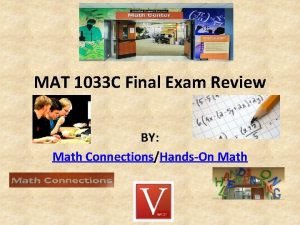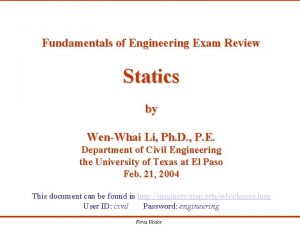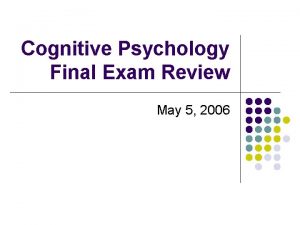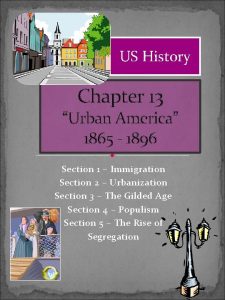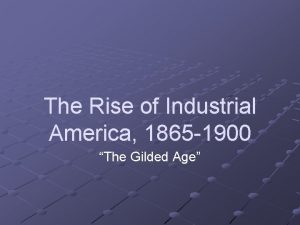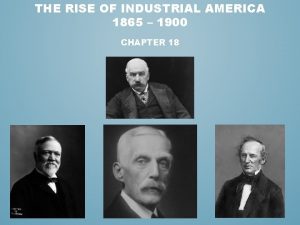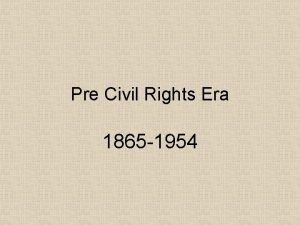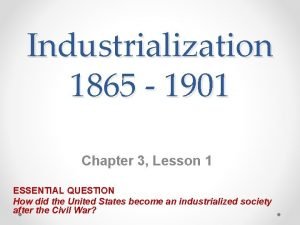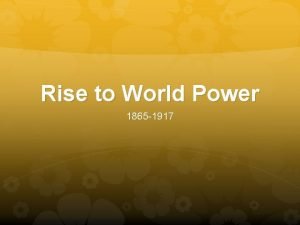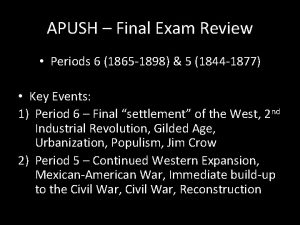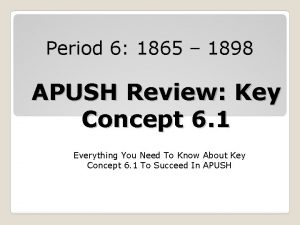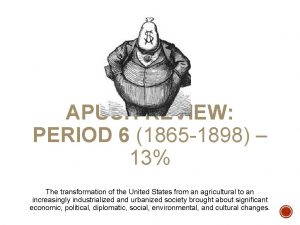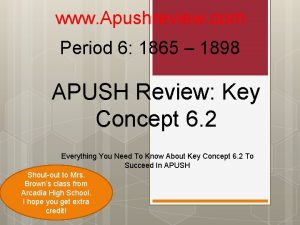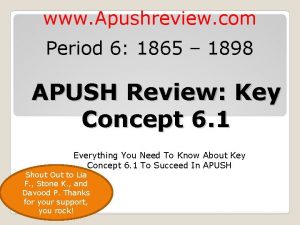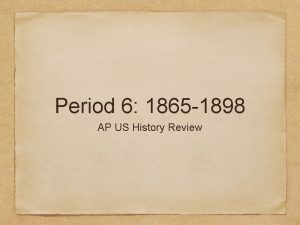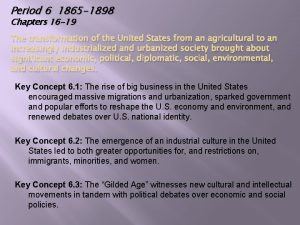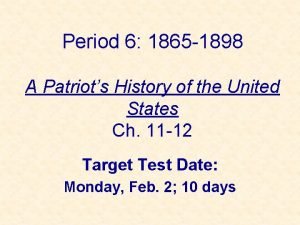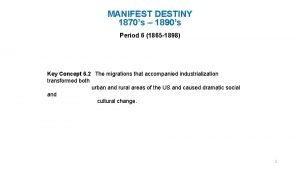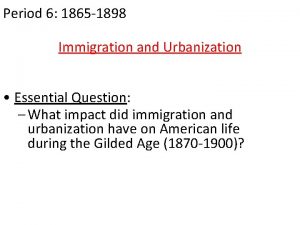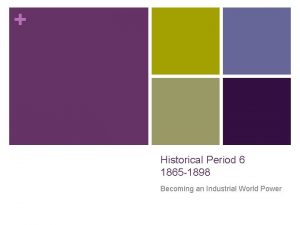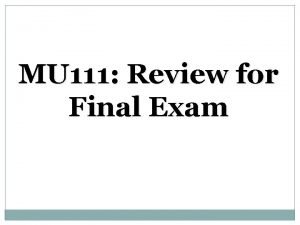APUSH Final Exam Review Period 6 1865 1898





































- Slides: 37

APUSH – Final Exam Review

Period 6 (1865 -1898) 1) In what ways did the railroads change America economically, politically, socially, and environmentally?

Possible Answers: • Economically – America’s first “big business”; moves people/goods faster; leads to increased speculation, boom/bust • Politically – gov’t subsidizes RR building through tax dollars; leads to strong connection between gov’t and industry; corruption occurs • Socially – helps “settle” the West; creates a new “aristocracy” of businessindustrialists; attracts more immigrants to build; leads to creation of reservations for Native Americans • Environmentally – leads to the destruction of the buffalo in the Plains; led to damming of rivers, clearing of land, increased mining, hunting

Period 6 (1865 -1898) 2) In what ways was Native American life affected during this time period?

Possible Answers: • Pacification – moving NAs onto reservations • Dawes Act – break-up of reservations into individual allotments for purpose of assimilation • Conflict between US gov’t and Apache, Sioux, Nez Perce, etc.

Period 6 (1865 -1898) 3) How was America changed during the time period of the Gilded Age economically, politically, and socially?

Possible Answers: • Economically – shift from an agricultural nation to an industrialmanufacturing nation; new wealth is created for entrepreneurs; machinery begins to replace human labor; American cities become centers of industry • Politically – Republicans become the “business-party”; Democrats control urban “machines”; Populists represent farmers/laborers (1890 s) • Socially – increased immigration from C. and E. Europe; rise of labor unions (AFL, K of L) and conflicts with management; overpopulation in cities; sharp differences between wealthy/poor; rise of “Social Darwinism” to explain wealth, success, and/or lack thereof

Period 6 (1865 -1898) 4) What factors led to the rise/continuation of “Jim Crow” in the South after the Civil War?

Possible Answers: • Failure of federal/state courts to enforce 14 th Amendment led to: -legalized segregation (Plessy v. Ferguson) -convict leasing for labor -violent reprisals by Southern whites for any attempt to resist • Failure of federal/state courts to enforce 15 th Amendment led to: -voting restrictions (literacy tests, poll taxes) -few black political leaders in South • Debate between black leaders over how to combat problems (economic self-improvement or strive for equal rights)

Period 7 (1898 -1900) 1) In what ways did overseas expansion benefit and challenge the US during this time period?

Possible Answers: • Benefits: 1) New markets for US-made goods 2) Increased competition with European empires 3) National prestige 4) Missionary/Christian obligation 5) Spread of democracy • Challenges: 1) War (against Spain and indigenous people – Philippines) 2) Betrayal of “original intent” (empire vs. republic)? 3) Financial burdens of maintenance

Period 7 (1890 -1945) 2) What effects did the Progressive Era have on US identity, labor, politics, environment, and ideas/beliefs/culture?

Possible Answers: • Identity – “Americanization” of sub-groups/immigrants; creating a “good society” through helping poor/destitute/uneducated • Labor – increased awareness about harsh conditions in workplace; greater recognition of workers’ rights/treatment • Politics – “good government” movement (attempting to rid corruption of Gilded Age); suffrage for women; “trustbusting”; income taxes • Environment – beginning of conservation movement • Culture – Prohibition and its impact, increased immigration

Period 7 (1890 -1945) 3) What impact did WWI have on the United States politically, economically, socially?

Possible Answers: • Political – increased power of fed. gov’t (CPI, WIB, etc. ); shift from “isolation” to “intervention”; making the world “safe for democracy”; fallout/debate over the Versailles Treaty; return to “isolation” afterward • Economic – more collaboration between gov’t-business-labor; increased employment opportunities; role of US banks/munitions companies prior to US involvement; destruction of Europe = more economic opportunity • Social – beginning of Great Migration from South; significant but overall fewer casualties than European belligerents; questions regarding “loyalty and patriotism” leading to 1 st Red Scare

Period 7 (1890 -1945) 4) In what ways did the 1920 s affect America politically, economically, and socially?

Possible Answers: • Politically – Harding/Coolidge/Hoover = business-oriented Presidents; passage of immigration restrictions & quotas; little/no gov’t assistance in the onset of Great Depression • Economically – wartime economy = more prosperous America; greater spending/advertising for consumer goods; greater speculation on Wall Street among average Americans; farmers are hard-hit by overproduction from war • Socially – new social attitudes/beliefs toward alcohol, sex, dress, leisure; the origin of a permanent “middle class” in the US

Period 7 (1890 -1945): 5) How were the first and second New Deals designed to combat the effects of the Great Depression?

Possible Answers: • 1 st New Deal 1) Reform – banking (ex: Glass. Steagall) 1) Relief – new jobs created by gov’t (ex: CCC) 2) Recovery – bringing back US business/industry (ex: NRA) • 2 nd New Deal 1) Response to liberal criticism of “not doing enough” in 1 st ND 2) More focused on solving “longterm problems” (poverty, disabilities, labor strikes) 3) Examples: Social Security, Wagner Labor Act

Period 7 (1890 -1945) 6) What were some of the overall impacts of the American experience in WWII?

Possible Answers: • Powerful manufacturing-based economy (ends Depression) • Virtual monopoly on world banking (Bretton Woods) • Powerful military/defense capabilities (A-Bomb) • Significant loss of life (but again not nearly as Europe/Asia) • Defeat of fascism/militarism but a new ideological “war” with the USSR • New “leadership” role in world affairs (due to Britain’s decline)

Period 8 (1945 -1980) 1) In what ways did the Cold War impact US identity and politics during this time period?

Possible Answers: • Identity – increased fear of Communism (Mc. Carthyism, HUAC); increased preparedness/paranoia (CMC, brinkmanship); increased competitiveness (1 st/2 nd Arms Race, Space Race, athletics); sense of democracy/capitalism being “good” • Politics: -containment (Truman, Eisenhower, Kennedy, LBJ; Nixon); massive retaliation (Eisenhower/Reagan); -détente (Kennedy, Nixon, Carter); alliances with like-minded nations; attempted increased influence over non-aligned nations (Vietnam, S. Korea, C. /S. America)

Period 8 (1945 -1980): 2) What specific impacts did the years of “postwar prosperity” have on the US from 1945 -1973?

Possible Answers: • Baby Boom (1945 -1955) • Rise of a larger middle class as a voting/tax base • Attempt to use prosperity to build a “Great Society” (LBJ 1964 -1968) • Greater advertising/consumer purchasing • Rise of suburban America and the “sunbelt” • “Traditional family values” as a standard • Higher college/university enrollment • Sense of idealism/service to nation (JFK - 1961)

Period 8 (1945 -1980) 3) How did the Civil Rights movement cause a shift in American ideas/beliefs/culture and identity?

Possible Answers: • Identity – Was segregation necessary? Federal power vs. states’ rights? Could non-violent protest bring about change? Was the movement just for African-Americans or could other marginalized groups (women, Latinos, Native Americans, homosexuals, etc. ) claim civil rights? • Culture – 1950 s/1960 s: differing goals/tactics; inclusion of student groups (CORE, SNCC); defiantly disobeying Southern state laws (Freedom Rides, Freedom Summer); linking up with anti-Vietnam War protests (1964 -1973)

Period 8 (1945 -1980) 4) What impacts did the 1970 s have on the US politically, economically, socially, and environmentally?

Possible Answers: • Politically – cost of the Vietnam War; Watergate; inefficient responses to economic problems; lower voter-turn outs; beginning of religious-conservative movement in politics • Economically – Stagflation; wage/price freezes due to energy crises; beginning of outsourcing and the “Rust Belt”; influx of foreign-made goods into US markets • Socially – continuation of push for civil rights (ERA, Affirmative Action, Title IX, abortion, etc. ) and push-back from those opposed • Environmentally – beginning of the EPA; search for alternative energy and consequences (3 Mile Island, etc. )

Period 9 (1980 -2000) 1) How did the conservative movement achieve political success by the beginning of this time period?

Possible Answers: • Impact of Goldwater’s 1964 campaign • Nixon/GOP “courting” of Southern voters in 1968 election • Formation of conservative groups/clubs across the Sunbelt and the South (John Birch Society, Young Americans for Freedom, etc. ) for networking/fundraising • Rise of evangelical Christianity as a political force

Period 9 (1980 -2000) 2) In what ways did the 1980 s and the Reagan Administration impact America domestically and internationally?

Possible Answers: • Tax cuts (ERTA) in 1981; record budget deficits tax increases by 1984; increased nat’l debt • Increased tensions w/USSR (19811984); eased tensions as USSR begins collapsing (1986 -1988) • Stabilizing of economy by 1984; lowered unemployment/higher median household income than 1970 s • Increased US spending on defense • Shift from industrial-manufacturing to service-based economy (due to outsourcing) • Decrease in union membership (due to outsourcing) • Greater US CIA-Military presence in C. /S. America • Responding to acts of “terrorism” against the US for its policies/positions

Period 9 (1980 -2000) 3) For what reasons did the US enter into a military conflict against Iraq in 1991? What were the overall consequences of this action?

Possible Answers: • Reasons For Conflict: 1) Iraqi invasion of Kuwait and threat of invasion of Saudi Arabia (both major oil suppliers to US) • Consequences 1) Kuwait is liberated; Saudi Arabia is safe 2) Low casualties for US (vindication for Vietnam? ) 2) President Bush receives a UN and 3) Saddam Hussein (Iraqi dictator) Congressional mandate to take remains in power action to liberate Kuwait and 4) Harsh sanctions against Iraq secure US economic interests (leading to mass poverty/death) 5) Continued US presence in M. E. increases tensions with Islamic fundamentalists (i. e. Bin Laden)

Period 9 (1980 -2000) 4) What overall impacts did the new era of “globalization” have on the US in the 1990 s?

Possible Answers: • Greater “interdependence” between nations in the world (G-8 meetings) • Greater competition between the US, Europe, and China for economic dominance (EU vs. NAFTA) • Rise of multi-national corporations across the world quest for cheap resources/cheap labor • Overall deregulation of banking industry and greater global investment lead to higher risks in the global economy
 Ap gov review final exam review
Ap gov review final exam review World history spring final exam review answers
World history spring final exam review answers Spanish packet answers
Spanish packet answers Human body systems final exam
Human body systems final exam Truss practice problems poe
Truss practice problems poe Ied final exam
Ied final exam World history b semester exam review practice
World history b semester exam review practice Principles of business final exam answer key
Principles of business final exam answer key Spanish 2 review packet answers
Spanish 2 review packet answers Environmental science final exam study guide
Environmental science final exam study guide World history final exam study guide
World history final exam study guide Us history semester 2 final exam review
Us history semester 2 final exam review English 4 semester 2 exam
English 4 semester 2 exam Physics 20 final exam practice
Physics 20 final exam practice Physical science final exam review
Physical science final exam review Mat 1033 final exam
Mat 1033 final exam Fe exam statics review
Fe exam statics review Zoology semester 1 exam review answers
Zoology semester 1 exam review answers Earth science sol review
Earth science sol review Algebra 1 final review packet
Algebra 1 final review packet Accounting 1 final exam
Accounting 1 final exam Personal finance final exam review
Personal finance final exam review Spanish 2 review
Spanish 2 review Psyc 1504 final exam
Psyc 1504 final exam Apush period 2
Apush period 2 Period 3 apush key concepts
Period 3 apush key concepts Reaganomics apush
Reaganomics apush Sunbelt apush
Sunbelt apush Apush period 2 review
Apush period 2 review Apush review period 6
Apush review period 6 Urban america 1865 to 1896
Urban america 1865 to 1896 Hollywood silver fox farm v emmett
Hollywood silver fox farm v emmett The rise of industrial america 1865-1900
The rise of industrial america 1865-1900 Four features of industrial manufacturing (1865-1900)
Four features of industrial manufacturing (1865-1900) 1954-1865
1954-1865 Industrialization (1865 to 1901 worksheet answers key)
Industrialization (1865 to 1901 worksheet answers key) Becoming a world power 1865-1917
Becoming a world power 1865-1917 What are characteristics of impressionism
What are characteristics of impressionism















